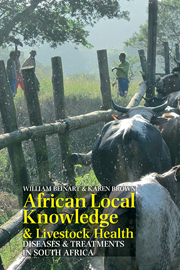Book contents
- Frontmatter
- Contents
- Acknowledgements
- Abbreviations
- Names of Common Diseases
- List of Maps, Photographs & Tables
- 1 Introduction: African Local Knowledge & Veterinary Pluralism
- 2 Ticks, Tick-borne Diseases & the Limits of Local Knowledge Introduction
- 3 ‘The Grave of the Cow is in the Stomach’: Environment & Nutrition in the Explanation & Prevention of Livestock Diseases
- 4 Transhumance, Animal Diseases & Environment
- 5 Plants & Drugs: Medicating Livestock
- 6 Medicinal Plants: Their Selection & their Properties
- 7 Animal Health & Ideas of the Supernatural
- 8 Gender, Space & the Supernatural
- 9 Conclusion
- Appendices
- Select Bibliography
- Index
2 - Ticks, Tick-borne Diseases & the Limits of Local Knowledge Introduction
Published online by Cambridge University Press: 05 December 2013
- Frontmatter
- Contents
- Acknowledgements
- Abbreviations
- Names of Common Diseases
- List of Maps, Photographs & Tables
- 1 Introduction: African Local Knowledge & Veterinary Pluralism
- 2 Ticks, Tick-borne Diseases & the Limits of Local Knowledge Introduction
- 3 ‘The Grave of the Cow is in the Stomach’: Environment & Nutrition in the Explanation & Prevention of Livestock Diseases
- 4 Transhumance, Animal Diseases & Environment
- 5 Plants & Drugs: Medicating Livestock
- 6 Medicinal Plants: Their Selection & their Properties
- 7 Animal Health & Ideas of the Supernatural
- 8 Gender, Space & the Supernatural
- 9 Conclusion
- Appendices
- Select Bibliography
- Index
Summary
‘The ticks suck the blood from animals and they die; there is no particular disease that causes death but they suck the blood’.
(Nongede Mkhanywa, Mbotyi)Introduction
South Africa is a hotbed of ticks. Anyone walking through the veld in rural areas knows their dangers. The Afrikaans word bosluise (bush lice) perhaps conveys their threat more vividly. For humans, they transmit tick bite fever, an uncomfortable and dangerous disease. They are even more hazardous for livestock. Over a century ago, scientists discovered that ticks are responsible for transmitting some of the country's most infectious diseases such as the ubiquitous gallsickness (anaplasmosis), East Coast fever (theilerosis), and redwater (babesiosis) that infect cattle, as well as heartwater (ehrlichiosis) which affects all ruminants. Despite a century of dipping to eradicate these diseases, ticks remain a scourge for many livestock owners, black and white, in South Africa.
Delving into the history of tick control is essential because it has preoccupied the state veterinary services and farmers alike. This is an exciting field of interdisciplinary research, traversing history, anthropology, entomology and epidemiology. Discussion of dipping as a means of control also opens up fascinating differences in the understanding of diseases and their treatment. We need to unravel the changing patterns of knowledge, and contestations over explaining the many tick-borne maladies that beset livestock in South Africa.
- Type
- Chapter
- Information
- African Local Knowledge and Livestock HealthDiseases and Treatments in South Africa, pp. 32 - 67Publisher: Boydell & BrewerPrint publication year: 2013



